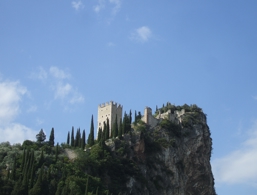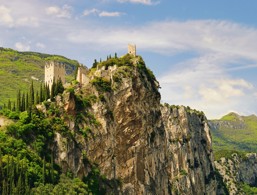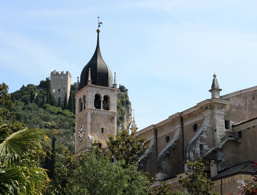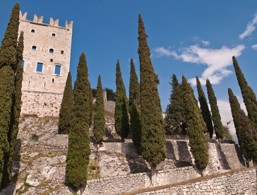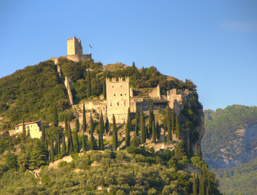The castle of Arco
The Castello di Arco is on a peninsula above Arco, not far from Lake Garda. Here, it crowns the Sarca Valley. In the north of the castle, rock falls steeply, while the south nestles a little gentler into the surrounding landscape, facilitating the climb.
You reach the castle, which was the former seat of the Counts of Arco, on a 120-meter-high footpath. A vast sunny landscape, the "Prato della Lizza", a beautiful green area opens up here high above sparkling Lake Garda. Particularly worth seeing are the large tower, the rock prison and the Sala dei Giochi (hall of the games), with a cycle of frescoes from the year 1380, depicting various game and knight scenes.
The history of the castle goes back about 1000 years. The Goths are said to have erected the Renghera tower with a ring wall around 500. Finally, around 1124, the Arcos built their fortress in this strategic location. The Arcos were known for their ruthlessness and lust for power. They resorted to means such as violence, schemes, betrayals and forgeries to spread their rule ever farther. From construction, the castle was an extremely popular asset and was the subject of many battles over the centuries.
In 1495 Albrecht Dürer immortalised the castle during his trip to Italy. In his watercolour, he particularly emphasises the southern character, which still distinguishes it surrounded by cypresses, olive trees and holm oaks.
Finally, in the 16th century, the general interest in the castle calmed down. The location on the steep rock no longer seemed ideal. Instead, they built residences at the foot of the fortress, on the shores of the lake. After a fire destroyed most of the castle in 1542, it was mainly used by bandits as a shelter. In 1703, the French General Vendôme made short work of the bandit castle as part of a French campaign and ordered a demolition. They starved the 700 men that sought refuge in the walls and the bandits ultimately had to surrender.
In 1982 the municipality of Arco attained possession of the castle ruins. It has been restored with the support of the province of Trento and is now open to the public.
